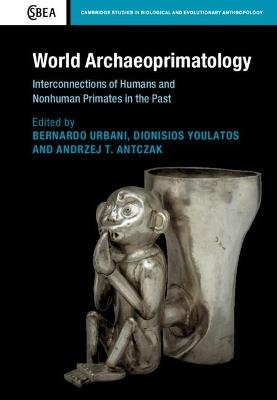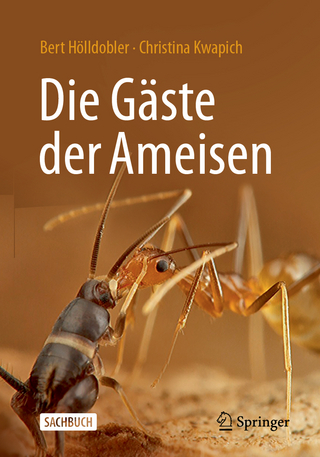
World Archaeoprimatology
Cambridge University Press (Verlag)
978-1-108-48733-7 (ISBN)
Archaeoprimatology intertwines archaeology and primatology to understand the ancient liminal relationships between humans and nonhuman primates. During the last decade, novel studies have boosted this discipline. This edited volume is the first compendium of archaeoprimatological studies ever produced. Written by a culturally diverse group of scholars, with multiple theoretical views and methodological perspectives, it includes new zooarchaeological examinations and material culture evaluations, as well as innovative uses of oral and written sources. Themes discussed comprise the survey of past primates as pets, symbolic mediators, prey, iconographic references, or living commodities. The book covers different regions of the world, from the Americas to Asia, along with studies from Africa and Europe. Temporally, the chapters explore the human-nonhuman primate interface from deep in time to more recent historical times, examining both extinct and extant primate taxa. This anthology of archaeoprimatological studies will be of interest to archaeologists, primatologists, anthropologists, art historians, paleontologists, conservationists, zoologists, historical ecologists, philologists, and ethnobiologists.
Bernardo Urbani is Associate Researcher at the Center for Anthropology of the Venezuelan Institute for Scientific Research, Caracas, Venezuela, and an elected member of the Global Young Academy. Recently, he was selected as a Fellow of the Alexander von Humboldt Foundation at the Leibniz Institute for Primate Research/German Primate Center, Göttingen, Germany. He has received the Martha J. Galante Award of the International Society of Primatology and the Early Career Achievement Award of the American Society of Primatologists. Dionisios Youlatos is Professor of Vertebrate Zoology in the School of Biology of the Aristotle University of Thessaloniki, Greece. He has done field and laboratory research on both extant and extinct primates and other mammals in South America, Europe, East Africa, and South East Asia. His research has been financially supported by both national and international funding. He is the author of more than a hundred articles and book chapters on the ecology, behavior, anatomy, and evolution of mammals. Andrzej T. Antczak is Associate Professor in Caribbean Archaeology in the Faculty of Archaeology, Leiden University, and Senior Researcher at the Royal Netherlands Institute of Southeast Asian and Caribbean Studies (KITLV-KNAW) in Leiden, the Netherlands. He is co-curator at the Unit of Archaeological Studies, Simón Bolívar University, Caracas, Venezuela, and recently served as chair of the Department of World Archaeology at Leiden University.
Foreword Raymond Corbey; Acknowledgments; World Archaeoprimatology: An introduction Bernardo Urbani, Dionisios Youlatos and Andrzej T. Antczak; Part I. The Americas: 1. Monkeys in the city of gods: on the primate remains and representations in Teotihuacan, central Mexico Bernardo Urbani, Carlos Serrano-Sánchez, Raúl Valadez-Azúa, Damián Ruiz-Ramoni and Rubén Cabrera-Castro; 2. Monkeys and the ancient maya: Using biological markers and behavior for primate species identification in maya iconography Katherine E. South and Susan M. Ford; 3. Monkeys on the islands and coasts of paradise: pre-hispanic nonhuman primates in the circum-Caribbean region (AD 300-1500) Bernardo Urbani, Andrzej T. Antczak, M. Magdalena Antczak, Nicole R. Cannarozzi, Roger H. Colten, Kitty F. Emery, Raymundo A.C.F. Dijkhoff, Thomas A. Wake, Michelle J. LeFebvre, Lisabeth A. Carlson, William F. Keegan and Dennis C. Nieweg; 4. Mirroring desert societies with monkeys: Primates in the late Prehispanic and early Colonial North Coast of Peru, Central Andes (circa AD 800-1600) Jorge Gamboa; 5. Alterity, authority and ancestors: Exploring monkey images in moche iconography of north coast Peru Aleksa K. Alaica; 6. Representations of primates in petroglyphs of the Brazilian Amazonia Edithe Pereira and José de Sousa e Silva Júnior; 7. Nonhuman primates in the archaeological record of Northeastern Brazil: A case study in Pernambuco state Albérico N. de Queiroz, Olivia. A. de Carvalho and Roberta R. Pinto; 8. Lice in howler monkeys and the ancient americas: exploring the potential cost of being past pets or hunting games R. Florencia Quijano, Debora R. Gilles, Jan Štefka and Martín M. Kowalewski; Part II. Europe: 9. The place of nonhuman primates in ancient roman culture: narratives and practices Marco Vespa; 10. Minoan monkeys: Re-Examining the archaeoprimatological evidence Bernardo Urbani and Dionisios Youlatos; Part III. Africa: 1. Primate behavior in ancient Egypt: The iconography of baboons and other monkeys in the old kingdom Lydia Bashfor; 12. The nonhuman primate remains from the baboon catacomb at Saqqara in Egypt Douglas Brandon-Jones and Jaap Goudsmit; 13. Primates in South African rock art: The interconnections between humans and baboons Ndukuyakhe Ndlovu; 14. Citizens of the Savanna: An account of three million years of interaction between baboons and hominins in South Africa Shaw Badenhorst; 15. Lemur Hunting in madagascar's present and past: The case of Pachylemur Natalie Vasey and Laurie R. Godfrey; Part IV. Asia: 16. The monkey in Mesopotamia during the 3rd Millennium BCE Marcos Such-Gutiérrez; 17. The great monkey king: carvings of primates in Indian religious architecture Alexandra A. E. van der Geer; 18. The prehistoric nonhuman primate subfossil remains at sigiriya potana cave, Sri Lanka Michael A. Huffman, Charmalie A.D. Nahallage, Tharaka Ananda, Nelum Kanthilatha, Nimal Perera, Massimo Bardi and Gamini Adikari; 19. Monkey hunting in early to mid-Holocene Eastern Java (Indonesia) Noel Amano, Thomas Ingicco, Anne-Marie Moigne, Anne-Marie Sémah, Truman Simanjuntak and François Sémah; 20. Dispersion, speciation, evolution, and coexistence of East Asian Catarrhine Primates and humans in Yunnan, China Gang He, He Zhang, Haitao Wang, Xueping Ji, Songtao Guo, Baoguo Li, Rong Hou, Xiduo Hou and Ruliang Pan; 21. Fossil and archaeological remain records of Japanese Macaques (Macaca fuscata) Yuichiro Nishioka, Masanaru Takai, Hitomi Hongo and Tomoko Anezaki; Index.
| Erscheinungsdatum | 10.08.2022 |
|---|---|
| Reihe/Serie | Cambridge Studies in Biological and Evolutionary Anthropology |
| Zusatzinfo | Worked examples or Exercises |
| Verlagsort | Cambridge |
| Sprache | englisch |
| Maße | 174 x 250 mm |
| Gewicht | 1200 g |
| Themenwelt | Geisteswissenschaften ► Archäologie |
| Naturwissenschaften ► Biologie ► Humanbiologie | |
| Naturwissenschaften ► Biologie ► Zoologie | |
| ISBN-10 | 1-108-48733-5 / 1108487335 |
| ISBN-13 | 978-1-108-48733-7 / 9781108487337 |
| Zustand | Neuware |
| Informationen gemäß Produktsicherheitsverordnung (GPSR) | |
| Haben Sie eine Frage zum Produkt? |
aus dem Bereich


